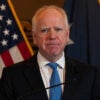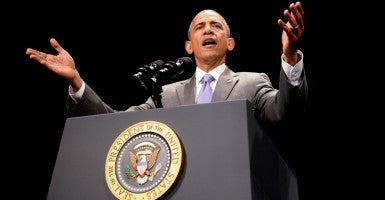During a news conference last week at the G-7 meeting in Germany, President Barack Obama acknowledged that his administration does not have a “complete strategy” to defeat the Islamic State group. That much is obvious. What’s as troubling as his strategic failure is the president’s explanation of why he has failed.
Obama defended himself with the promise that “When a finalized plan is presented to me by the Pentagon, then I will share it with the American people. We don’t yet have a complete strategy because it requires commitments on the part of the Iraqis as well about how recruitment takes place, how that training takes place. So the details of that are not yet worked out.”
The idea that we need to have every detail of an operational plan worked out to have a strategy is completely wrong. In 1944, the Allies had a strategy to win the war: Invade northern France, beat the Germans, and force the Nazis to surrender unconditionally.
Of course it mattered where the paratroopers were dropped. The success of any strategy depends on tactics and execution. But the concept of D-Day came first: We planned the nuts and bolts later. The president, by contrast, has failed to offer a vision and to drive his subordinates to work out the details.
He has not set out America’s fundamental interests in the Middle East. He has sided inconsistently with Iran in Syria and Iraq, and with the Saudis against Iranian-supported rebels in Yemen. He has waffled to and fro on Egypt, drawn and ignored red lines, and lambasted Israel while sidling up to Iran.
The results are predictable. The Islamic State controls more territory than it did when the U.S.-led campaign began last August. Iran’s influence is growing too, while ours is waning fast.
The administration now promises more and improved training. We’ve heard that before. With our record of abandoning our friends in Iraq to the Islamic State’s assassination campaign, only the brave or the foolish will side with us now. By the time Obama gets his “finalized plan,” it will be as out of date as his red lines.
Obama’s emphasis on the Pentagon is equally wrong. Our strategy can’t be purely military. So it’s not the Pentagon’s job to plan strategy: It’s the government’s job. It also involves the State Department, the Treasury, the intelligence agencies, working through the National Security Council in the White House.
What is most troubling is Obama’s implication that his role is to wait on the Pentagon to produce a product, and then, like a cashier at McDonald’s, to hand it over the counter to the American people. He’s blaming the American military for failing to do a job that actually belongs to him.
How does a leader drive the creation of a strategy? By doing what Winston Churchill did brilliantly during the Second World War. Churchill spurred his ministers, generals, and civil servants on by setting out a strategic vision, and then constantly asking questions, inspecting statistics, and proposing initiatives.
As one subordinate put it, Churchill’s great talent lay “in goading people into giving up their cherished reasons for not doing anything at all.” Churchill commanded his ambassadors to “pester, nag and bite.” His label on his most urgent memoranda demanded “ACTION THIS DAY.”
The Islamic State took control of Fallujah a year ago. Yet by Obama’s own admission, we still lack a strategy. That is not the Pentagon’s fault. Obama does not talk like a man who demands action, and in that, he is being honest. Unlike Churchill, he is content with inaction this day. The failure is his alone.
































